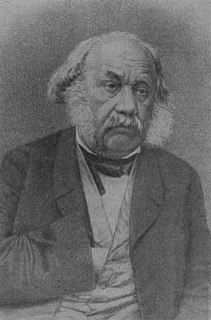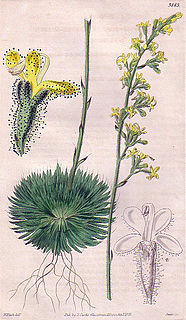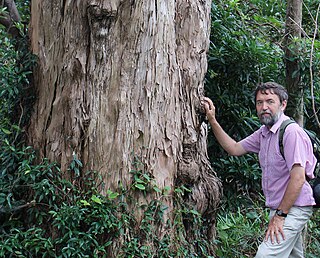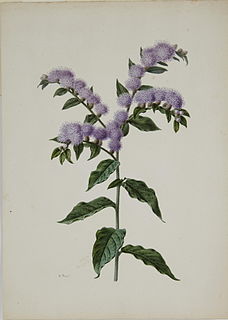
The Arnold Arboretum of Harvard University, established in 1872, is the oldest public arboretum in North America. This botanical research institution and free public park is located in the Jamaica Plain and Roslindale neighborhoods of Boston, Massachusetts. The landscape was designed by Charles Sprague Sargent and Frederick Law Olmsted and is the second largest "link" in the Emerald Necklace. The Arnold Arboretum's collection of temperate trees, shrubs, and vines has a particular emphasis on the plants of the eastern United States and eastern Asia, where Arboretum staff and colleagues are actively sourcing new material on plant collecting expeditions. The Arboretum supports research in its landscape and in its Weld Hill Research Building.

Elmer Drew Merrill was an American botanist and taxonomist. He spent more than twenty years in the Philippines where he became a recognized authority on the flora of the Asia-Pacific region. Through the course of his career he authored nearly 500 publications, described approximately 3,000 new plant species, and amassed over one million herbarium specimens. In addition to his scientific work he was an accomplished administrator, college dean, university professor and editor of scientific journals.

Nikolai Stepanovich Turczaninow was a Russian botanist and plant collector who first identified several genera, and many species, of plants.

The elm cultivar Ulmus 'Koopmannii' was cloned from a specimen raised from seed sent from Margilan, Turkestan by Koopmann to the Botanischer Garten Berlin c. 1880. Noted in 1881 as a 'new elm', it was later listed by the Späth nursery, catalogue no. 62, p. 6. 101, 1885, as Ulmus Koopmannii, and later by Krüssmann in 1962 as a cultivar of U. minor. Margilan is beyond the main range of Ulmus minor. Augustine Henry, who saw the specimens in Berlin and Kew, believed Koopmann's Elm to be a form of Ulmus pumila, a view not shared by Rehder of the Arbold Arboretum. Ascherson & Graebner said the tree produced 'very numerous root shoots', which suggests it may be a cultivar of U. minor. Until DNA analysis can confirm its origin, the cultivar is now treated as Ulmus 'Koopmannii'.

The Harvard University Herbaria and Botanical Museum are institutions located on the grounds of Harvard University at 22 Divinity Avenue, Cambridge, Massachusetts. The Botanical Museum is one of three which comprise the Harvard Museum of Natural History.

Oakes Ames was an American biologist specializing in orchids. His estate is now the Borderland State Park in Massachusetts. He was the son of Governor of Massachusetts Oliver Ames and grandson of Congressman Oakes Ames.

The National Herbarium of Victoria is one of Australia's earliest herbaria and the oldest scientific institution in Victoria. Its 1.5 million specimens of preserved plants, fungi and algae—collectively known as the State Botanical Collection of Victoria—comprise the largest herbarium collection in Australia and Oceania.
The Seed Herbarium Image Project (SHIP), is an initiative of the Arnold Arboretum of Harvard University to create a web-based repository of high-resolution digital images documenting the morphology of woody plant seeds and selected fruit structures. Headquartered at the Arboretum’s Dana Greenhouse facility and coordinated and photographed by curatorial assistant Julie McIntosh Shapiro, the Seed Herbarium Image Project supports the work of educators and professionals in horticulture and the botanical sciences, particularly in conservation research and management of rare and endangered species. The digitized images of seeds offer an important new aid for teaching seed identification—a fundamental skill in plant propagation, hybridization, and distribution—and serve as a resource for nurserymen, horticulturists, botanical curators, taxonomists, ecologists, and the general public. SHIP also provides an online resource for botanical institutions and nurseries to verify their collections and inventories. SHIP is made possible through the generous support of the Stanley Smith Horticultural Trust, Cabot Family Charitable Trust, and the J. Frank Schmidt Family Charitable Foundation.

Charles Edward Faxon was an American botanical artist and instructor of botany born in Jamaica Plain, Massachusetts. The standard author abbreviation Faxon is used to indicate this person as the author when citing a botanical name.

Stephen Elliott was an American legislator, banker, educator, and botanist who is today remembered for having written one of the most important works in American botany, A Sketch of the Botany of South-Carolina and Georgia. The plant genus Elliottia is named after him.

A botanical and horticultural library is a library specializing in the preservation and collection of literature and materials about plants. The mission of many botanical and horticultural libraries is to make accessible and available to those who use it the information on this topic.

Rácz István is a Hungarian dendrologist, curator, and museologist.
Irving Widmer Bailey was an American botanist known for his work in plant anatomy.
Lily May Perry (1895-1992) was a Canadian-American botanist who worked at Arnold Arboretum and is most known for detailed compilation of information on medicinal plants of East and Southeast Asia and her assistance with the Flora of New Guinea. Perry also has the legacy of authoring the third highest number of land plant species among female scientists, in total naming 414 species.
Edwin Bunting Bartram was an American botanist and bryologist. He described many dozens of new species in bryology, and contributed 143 works, including a number of books. He was a member of the Academy of Natural Sciences, Philadelphia Botanical Club, Torrey Botanical Club, New England Botanical Club, Sullivant Moss Society and British Bryological Society.

Alfred Riocreux, a French scientific illustrator and described as the "most distinguished botanical artist of his day".

Kancheepuram (Kanchi) Natarajan Gandhi is Senior Nomenclature Registrar and Bibliographer at Harvard University in the Department of Botany in the Harvard University Herbaria & Libraries. He manages a botanical classification project to identify and classify all plants in the Western world through his role at Harvard, where Harvard's newly adopted “open-access digitization policy” assigns to the public domain most of the images of plants he and others have classified and preserved.
Susan Adams Delano McKelvey (1883-1964) was an American botanist and author, noted for her work at the Arnold Arboretum. The standard author abbreviation McKelvey is used to indicate this person as the author when citing a botanical name.
Geneva Sayre was a bryologist and bibliographer. She "pioneered bibliographical and historical bryology, a new field in the study, evaluation, and organization of the literature of bryology."
Norton George Miller (1942–2011) was an American bryologist and paleobotanist. He was the president of the American Bryological and Lichenological Society from 1985 to 1987.












